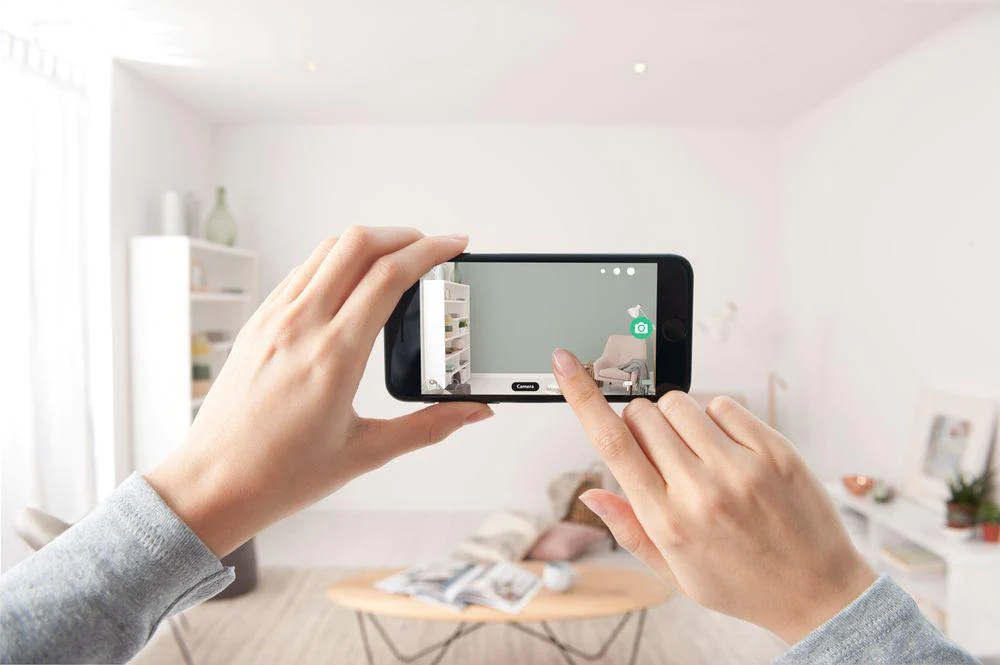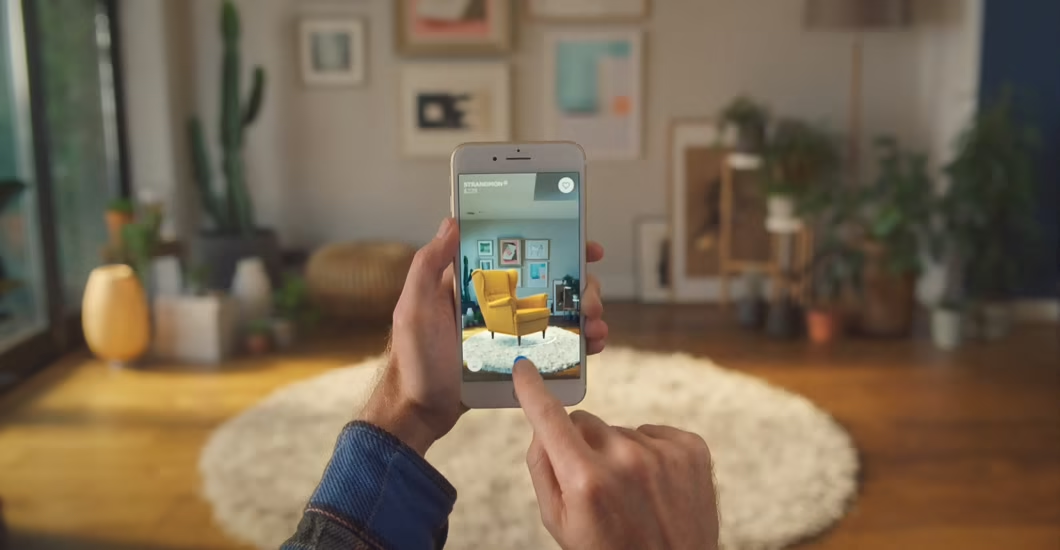Retail AR is growing particularly fast in Europe. Statista data shows that the market size is set to grow from 2.8 billion U.S. dollars in 2021 to 20.9 billion U.S. dollars in 2025, with Germany placing a particular emphasis on using the technology.
Across the pond, a study by Threekit reveals that 17% of U.S. consumers will use AR monthly this year.
What’s the Difference Between Augmented Reality (AR) and Virtual Reality (VR)?
The biggest difference between virtual reality and augmented reality is that VR creates an entire world for users to immerse themselves in, while AR “augments” the real world through a screen.
Consumers need a headset to access virtual reality scenes, but augmented reality is used to show additional computer-generated objects, items, and information laid on top of real-world scenes.
In the retail world, AR can be used on:
- Smartphones and tablets;
- Wearables;
- Desktop devices;
- TVs;
- Digital mirrors; and
- Connected devices, like glasses, headsets, and lenses.
The possibilities are almost endless for providing a semi-immersive experience for shoppers.
Why Brands and Retailers Are Choosing AR
AR not only creates an innovative new way for consumers to shop, but it also provides plenty of benefits to the retailers and brands who are implementing it.
Reduce the Number of Returns
Allowing customers to virtually try on clothes and products before they buy them dramatically reduces the number of returns.
Increase Customer Engagement
Customers can play around with makeup colors, try on eyeglasses, and “put on” clothes without too much effort, increasing engagement with brands and their products.
Build Customer Loyalty
Giving customers what they want and ensuring their shopping experience is seamless will ultimately lead to long-term loyalty.
Collect Customer Data
Brands and retailers can use information from their AR activities to understand more about their customers, like their clothing sizes, product preferences, and buying habits.
Increase Sales
Customers are more likely to purchase products that they can “try out” hassle-free.
7 Engaging Ways Brands and Retailers Are Using Augmented Reality in Retail
1. Color Matching
It’s difficult for a customer to tell what a specific color of paint or lipstick will look like on their wall or against their skin tone — even when the item is right in front of them in person. It’s even more difficult to tell the color of a product through a screen.
AR can help customers match paint colors and makeup palettes by either laying the paint or lipstick over a photo. The Dulux Visualizer app does exactly this — making it easier than ever for shoppers to choose the right wall color for their homes. 
2. Virtual Fitting Rooms
Clothing is a category that presents a unique set of challenges for online shoppers. It can be difficult for a consumer to look at a product photo and visualize how the clothing item will look in real life on their own unique body.
Brands and retailers such as ASOS, Gucci, and Knix have experimented with virtual fitting rooms as a means to help shoppers find the right size and style — without having to visit a physical store.
3. Interactive In-Store Displays
Once customers enter a store, it’s important to keep them engaged enough to purchase. Installing in-store displays with AR features can help shoppers browse your product catalog, personalize items, and find products that are a match for their style or skin tone.
As The New York Times reports, Sephora’s in-store AR displays let shoppers personalize their entire shopping experience through virtual makeup try-ons, technology that matches their skin tone to different types of makeup, and even the ability to sample perfume via a touchscreen.
4. Virtual Try-Ons
Shoppers are often hesitant to buy a product if they’re not sure it will look good on them. Similar to virtual fitting rooms, brands and retailers are using AR technology to let shoppers try on accessories and other items, like eyeglasses and hats.
Warby Parker has an AR app that lets shoppers upload a selfie to see how different types of eyeglasses look on them. The app works in tandem with the mobile site so customers can instantly add products they like to their cart.
5. Space Visualization
It’s difficult to picture what a sofa will look like in a room without it actually being in the room. AR can help customers visualize how large furniture items will fit into their homes or offices — without having to commit to a purchase first.
Ikea’s AR app lets shoppers scan their room and place computer-generated, to-scale photos of their chosen products in the space
Image Source: Ikea
6. Encourage Brand Engagement
Engagement is crucial for securing sales and retaining customers. Keeping shoppers entertained while they explore your products — and giving them a way to interact with your brand — can ensure they come back time and time again.
As Tech at Meta reports, Starbucks has used AR to engage its customers by allowing them to scan their cups with their smartphones to create an animated scene.
7. Provide Additional Content
Customer relationships extend beyond the initial purchase. Securing long-term loyalty requires providing relevant content to shoppers to continue reminding them why they bought your product — and why they should buy from you again.
Francesco Rinaldi has implemented an AR app that provides recipes and additional information about the brand’s sauces when a customer points their phone at the face of Mrs. Rinaldi.
Video Source: Twisted Rope
5 Retail Verticals That Really Benefit From AR
There are multiple types of brands and retailers that are using AR to enhance the customer experience. Research by Eclipse found that 77% of people who use AR do so to see product differences — like variations of colors and styles — because they can see these differences up-close, at different angles, and in their own space.
The research also found that 65% of AR users leverage this technology to find out more about a product, and 61% would choose to shop with stores that have AR over those that don’t.
Combined with the use cases above, these stats show that AR is most helpful for brands and retailers that sell large items, products that have different color variations, and items (like clothes and makeup) that customers will likely want to try on.
Given these insights, here are some verticals that can benefit from AR technology:
- Fashion;
- Makeup and beauty;
- Furniture and homeware;
- Paint and wallpaper; and
- Food and beverage.
AR: A Sought-After Tool in the Commerce Landscape
As technology advances and competition increases, retailers are having to get creative with how they engage and attract customers. AR provides a powerful way to show customers what products look like in their own space, while removing many of the friction points in the shopping process — such as trying on clothes, choosing the right color, and measuring furniture.
If you haven’t already experimented with AR in your brick-and-mortar store or on your ecommerce site, now’s the time to do so. Threekit’s research shows that only 1% of retailers are currently using AR or VR in their customer buying experience. By implementing this technology in new and exciting ways, you can get ahead of the curve and stand out amongst your competitors.
Learn more about the latest consumer trends and preferences in our “Consumer Research 2022” report.





![7 Best Warehousing and Fulfillment Services + How to Choose One [2022]](https://thegateway.net.au/wp-content/uploads/2022/10/7-best-warehousing-and-fulfillment-services-how-to-choose-one-2022-768x402.png)
